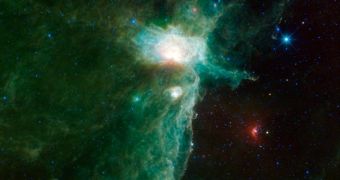Astronomers handling the impressive dataset compiled by the NASA Wide-field Infrared Survey Explorer (WISE) during its mission have just revealed an amazing new image of the Flame nebula, a candle-like cosmic structure trapped in a massive dust cavern.
Located in the Orion complex, a formation near the constellation's famous Orion's Belt, the nebula is seen here in multiple infrared wavelengths, displaying a monumental light show. The photo was made available on July 2, 2012, alongside other components of the massive database.
NASA launched WISE into a Sun-synchronous polar orbit on December 14, 2009, from Space Launch Complex 2W at the Vandenberg Air Force Base. The spacecraft made its way to space aboard a Delta II delivery system, with the purpose of surveying the entire night sky one and a half times.
The all-sky catalog and atlas it compiled in infrared wavelengths was released in March 2011. It covers 500+ million objects, including asteroids, stars and entire galaxies, and identified 33,500 new asteroids and comets, as well as 154,000 objects that previously went undetected in the solar system.
“If you're an astronomer, then you'll probably be in hog heaven when it comes to infrared data. Data from the second sky scan are useful for studying stars that vary or move over time, and for improving and checking data from the first scan,” says Edward Wright.
The expert, who is based at the University of California in Los Angeles (UCLA), holds an appointment as the principal investigator of the WISE mission. He explains that all the colors visible in the new image correspond to a different IR channel on the telescope's sensitive detectors.
The bright glow characterizing the Flame nebula comes from the multiple massive stars - weighing at least 8 solar masses – that are constantly being formed from the structure's massive hydrogen clouds.
At the center of the nebula lies a massive star around 20 times heavier than the Sun, and smothered in a thick layer of dust. It is invisible to observatories conducting studies in optical wavelengths.
According to astronomers, this star would appear at least as bright as the three main stars in Orion's Belt, but the thick dust around it makes it seem as if it's 4 billion times fainter than it actually is.
During the time WISE was operational (until February 17, 2011), the telescope was managed and operated for the Science Mission Directorate, at NASA Headquarters in Washington DC, by experts at the NASA Jet Propulsion Laboratory (JPL), in Pasadena, California.

 14 DAY TRIAL //
14 DAY TRIAL //